“Destination Asia: Eastern Orientalism”
Participants of the conference
(Click on the image for full view)
JAPAN-THAILAND-GERMANY:
Keiko Sei
A writer and a curator who has lived and worked in Japan , Eastern Europe and Southeast Asia . Her activities are research, seminars, workshops, exhibitions, and writings on independent media and culture and that include: symposium and book on the role of television in the Romanian Revolution, examination of Nikola Tesla, international exhibition of political art in Prague, book of essays on society of transition Terminal Landscape, and most recently, she has organized a series of events entitled Asia Week for documenta 12. The countries that she has given intensive seminar/workshop on independent video and media include Kazakhstan , Georgia and Burma , and she has written for publications worldwide.
“Aesthetic of Dependence”
Recent culture - both in commercial and in fine art - in Japan , which is rapidly sweeping throughout Eastern and Southeastern Asia , has indicated that the more Asian countries are technologically developed the more they produce “culture of dependence”. Economic development doesn't necessarily bring cultural maturity but rather, it influences culture in the opposition direction of dependency and indulgence, as we can see in the popularity of Hallo Kitty, Takashi Murakami, Yoshitomo Nara and numerous manga characters. This phenomenon also intricately linked to the immaturity of democracy in the region. In this regard, the Asian part of the former Soviet Union is an interesting place to closely observe, in order for us to understand the relation between the maturity of politics, democratic concept, culture and aesthetics. This presentation thus will talk about different factors behind the appreciation of frail and cute aesthetic that might arrive in Central Asia anytime soon, anticipating economic boom of the region.
ITALY:
Enrico Mascelloni
 Enrico Mascelloni born in 1954, lives and works in Rome . He published on both art and geopolitical themes. He has traveled extensively to Africa, Central Asia, Afghanistan, Pakistan; his most recent books resulting from these travels are “The Tamerlane Syndrome” (on Central Asian contemporary art), “Caravan Café”, “The Nightmare of Modernism” (on Afghan war carpets), and “A thousand and one day” (on Pakistan contemporary art).
Enrico Mascelloni born in 1954, lives and works in Rome . He published on both art and geopolitical themes. He has traveled extensively to Africa, Central Asia, Afghanistan, Pakistan; his most recent books resulting from these travels are “The Tamerlane Syndrome” (on Central Asian contemporary art), “Caravan Café”, “The Nightmare of Modernism” (on Afghan war carpets), and “A thousand and one day” (on Pakistan contemporary art).
”To East of Nothing”:
My topic is the geopolitics of the Central Asian contemporary art in the epoch of neocolonialism; the ways in which western museums (and western market) is interested to receive Central Asian and more in general contemporary art from Asia and Africa.
INDIA:
Amrita Gupta-Singh
 Amrita Gupta Singh is an art theorist and writer based in Mumbai , India . She has earned a postgraduate degree in Art History from Kalabhavana, Vishwabharati University , Santiniketan (2002) and undergraduate degrees in Applied Art (2000) from Rabindra Bharati University , Kolkata, and in Philosophy (1994) from the North Eastern Hill University , Shillong, respectively. She has taught art courses as a Visiting Lecturer at undergraduate and post graduate levels at the JJ School of Arts (2003), and currently, she is the Program Director at the Mohile Parikh Center for the Visual Arts, NCPA, which she joined in 2002. In this capacity, she has conceptualized, initiated and organized diverse programs including presentations, discussions, public art projects and international conferences. She also writes regularly on artists and art events, for books, art journals, exhibition catalogues and magazines, and has participated as an invited observer in international conferences and seminars in India . Her academic interests include Modern Indian Art, Contemporary Art, Cultural Studies and Public Art Initiatives.
Amrita Gupta Singh is an art theorist and writer based in Mumbai , India . She has earned a postgraduate degree in Art History from Kalabhavana, Vishwabharati University , Santiniketan (2002) and undergraduate degrees in Applied Art (2000) from Rabindra Bharati University , Kolkata, and in Philosophy (1994) from the North Eastern Hill University , Shillong, respectively. She has taught art courses as a Visiting Lecturer at undergraduate and post graduate levels at the JJ School of Arts (2003), and currently, she is the Program Director at the Mohile Parikh Center for the Visual Arts, NCPA, which she joined in 2002. In this capacity, she has conceptualized, initiated and organized diverse programs including presentations, discussions, public art projects and international conferences. She also writes regularly on artists and art events, for books, art journals, exhibition catalogues and magazines, and has participated as an invited observer in international conferences and seminars in India . Her academic interests include Modern Indian Art, Contemporary Art, Cultural Studies and Public Art Initiatives.
“Articulating the ‘Other': Some Reflections”
Contemporary Indian art is booming, biennales and art fairs are mushrooming, culture is a global industry, and due to large-scale economic, global, political, and socio-cultural change, and the momentum of the transference of concepts, currency, information and cross-cultural contacts around the globe, art practices has been radically transformed in our times. Given the changing dynamics of global sociology, economy and art, are we ‘the rest', as opposed to the ‘West', still positioning ourselves as the polar opposites of ‘inferior Oriental' versus the ‘superior Occidental'?
The binaries of the ‘East' and the ‘West' are continuing debates both in academies and public life. How does one contextualize contemporary Orientalism and Globalism? Western theories of Asia reflect, to an important extent, power relations between Western/centre and Asian/periphery societies, and this connection calls for critical reflection, as exemplified in Edward Said's seminal book, ‘Orientalism' published in 1978, which radicalized cultural scholarship, especially in Asia and particularly India. The central component of Said's argument was that orientalism as a discourse arose initially in Christianity as part of a missionary interest in the control of the Other by knowledge, and in the case of India , British Orientalism introduced a rationalist study of Indian texts, while aiding imperialist policies, to know, understand and conquer. This conundrum of knowledge and power from a historical perspective and its contradictory relations (intellectual, administrative, and cultural) between the colonial past and the postcolonial present, pose a peculiar predicament, especially when scrutinized against capitalist/globalized structures and the politics of difference.
The problem of ‘Other' cultures has been a persistent aspect of Western thought and Western hegemony. This notion of the essentialized ‘othering' resulted in variants of power and imposition In Indian politics and culture. The origin of the concepts of art, folk art, craft, classical art, fine art and decorative art as applied to the Indian situation owes much to the 18th and 19th century anthropological discoveries and resultant colonization. The British colonialist rule had tried to eradicate any vestiges of the ancient craft guild system, in its attempts of modernization, and its effects can be felt even today in the contemporary art scenario in the binaries of ‘Art' and ‘Craft'.
In this paper, I attempt to interrogate the trajectories of how indeed, the concept of ‘Art' itself was the inheritance of a European Modernist ideal that actively inscribed itself in re-writing the histories of non-western cultures. The imposition of western notions of art gave birth to such categorizations, and since then ‘fine art' and ‘classical art' began to be used as interchangeable terms, while the decorative, the folk or craft became synonymous. Even after independence, while instituting the nation in Art, the preference has always been for the ‘classical', hence ‘higher/sublime/spiritual/Indian' became discursive terminologies. In a polar opposite the art from rural areas became classified as ‘handicrafts' made by anonymous craftsmen/women, self-trained in a generational guild system who ‘produced', while the art academy (also introduced by the British) trained ‘modern' artist assumed celebrity status as ‘creators' of art. This double construct of orientalism; orientalism as a western's other and the orientalist position as an indigenous othering process is what I will explore in my paper, positioning that the ‘contemporary' is not necessarily identical with the urban via the urban-rural interface in contemporary Indian art. Tradition/Modernity/Contemporaneity are mutually inclusive paradigms and such an understanding would aid in normalization of diverse aesthetic practices co-existing in our times, instead of the polarized notions of visual practices that the British imposed on South Asian cultures.
Ranjit Hoskote
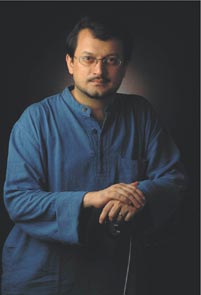 Cultural theorist, art critic, poet and curator, author of fourteen books. These include five collections of poetry, the most recent of which are Vanishing Acts: New & Selected Poems 1985-2005 ( Delhi : Penguin, 2006) and Die Ankunft der Vögel ( Munich : Carl Hanser Verlag, 2006), and six monographs on artists, most recently, The Crafting of Reality: Sudhir Patwardhan, Drawings ( Bombay : The Guild, 2008). He has also published a translation of Vasant Dahake's poems, A Terrorist of the Spirit (Delhi: Harper Collins, 1992), an anthology of contemporary Indian verse, Reasons for Belonging (Delhi: Viking, 2002), and a history of cultural confluence, co-authored with the German writer Ilija Trojanow, Kampfabsage (Munich: Random House/ Blessing Verlag, 2007). Hoskote has also curated fourteen exhibitions of modern and contemporary art, including a mid-career retrospective of Atul Dodiya (Japan Foundation, Tokyo, 2001) and a lifetime retrospective of Jehangir Sabavala (National Gallery of Modern Art, Delhi and Bombay, 2005-2006). Was co-curator for the trans-Asian collaborative project, ‘Under Construction' ( Tokyo and other Asian centres, 2001-2002), and is co-curator of the 7th Gwangju Biennale (2008).
Cultural theorist, art critic, poet and curator, author of fourteen books. These include five collections of poetry, the most recent of which are Vanishing Acts: New & Selected Poems 1985-2005 ( Delhi : Penguin, 2006) and Die Ankunft der Vögel ( Munich : Carl Hanser Verlag, 2006), and six monographs on artists, most recently, The Crafting of Reality: Sudhir Patwardhan, Drawings ( Bombay : The Guild, 2008). He has also published a translation of Vasant Dahake's poems, A Terrorist of the Spirit (Delhi: Harper Collins, 1992), an anthology of contemporary Indian verse, Reasons for Belonging (Delhi: Viking, 2002), and a history of cultural confluence, co-authored with the German writer Ilija Trojanow, Kampfabsage (Munich: Random House/ Blessing Verlag, 2007). Hoskote has also curated fourteen exhibitions of modern and contemporary art, including a mid-career retrospective of Atul Dodiya (Japan Foundation, Tokyo, 2001) and a lifetime retrospective of Jehangir Sabavala (National Gallery of Modern Art, Delhi and Bombay, 2005-2006). Was co-curator for the trans-Asian collaborative project, ‘Under Construction' ( Tokyo and other Asian centres, 2001-2002), and is co-curator of the 7th Gwangju Biennale (2008).
The Nomad And the Nation-state:
Notes Towards a Theory of Critical Transregionality”
One of the primary carriers of what has been called ‘eastern Orientalism' is the mythology of the nation-state and its attendant national culture, as promulgated and enforced in many postcolonial societies. This mythology simultaneously presumes, at a conceptual level, and seeks to produce, at the level of everyday practice, an individual citizen who embodies the national self. Such a conscriptive manoeuvre limits the cultural as well as the political agency of the individual citizen, and becomes an increasingly limiting and oppressive barrier to growth in an epoch that has made an economic globalisation as well as a cultural globalism possible. I propose, in the course of this paper, to explore the possibility of redefining a contemporary selfhood by means of actively re-reading one's regionality in the wider contexts of shifting civilisational linkages, affinities of practice, lattices of conversation, and, crucially, a nomadism of intense engagements that transcends the outmoded yet persistent boundaries of the nation-state and national culture. Such a nomadism accords with the dramatic shifts in practice and self-perception among cultural practitioners in recent years; it also critiques the notion of civilisational blocs and spheres of influence, which incarnate the archaism of Cold War area studies and indeed, may be traced back to the imperialist spirit of the Congress of Vienna. In the process, I wish to outline the contours of what Nancy Adajania and I have termed a theory of critical transregionality.
Nancy Adajania
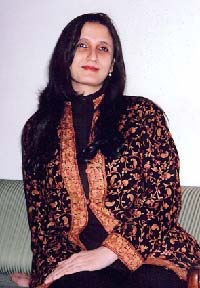 Nancy Adajania is a cultural theorist, art critic and independent curator. She has written and lectured extensively on contemporary Indian art, especially new-media art and its political and cultural contexts, at international venues such as Documenta 11, Kassel; the Zentrum fur Kunst und Medientechnologie (ZKM), Karlsruhe; the Neuer Berliner Kunstverein and the Transmediale, Berlin, among others.Adajania has contributed essays and reviews to Documenta 12 Magazine No.2/ Life! ( Kassel ) Cologne: Taschen, 2007), as well as Springerin (Vienna), Metamute (London), Public Art (Minneapolis), Metropolis M (Utrecht), Art 21 (Paris), Art Asia Pacific (New York), and X-tra (Los Angeles). She was co-curator for the exhibition Zoom! Art in Contemporary India (Culturgest, Lisbon , April 2004) and curated Avatars of the Object: Sculptural Projections(The Guild/ NCPA, Bombay , August 2006). Adajania was also contributing curator to Thermocline of Art: New Asian Waves (ZKM, Karlsruhe , June 2007).Adajania's archive-installation, ‘In Aladdin's Cave', has been exhibited at the Wuerttembergische Kunstverein, Stuttgart (February 2006) and Waterman's Gallery, ( London , 2007).
Nancy Adajania is a cultural theorist, art critic and independent curator. She has written and lectured extensively on contemporary Indian art, especially new-media art and its political and cultural contexts, at international venues such as Documenta 11, Kassel; the Zentrum fur Kunst und Medientechnologie (ZKM), Karlsruhe; the Neuer Berliner Kunstverein and the Transmediale, Berlin, among others.Adajania has contributed essays and reviews to Documenta 12 Magazine No.2/ Life! ( Kassel ) Cologne: Taschen, 2007), as well as Springerin (Vienna), Metamute (London), Public Art (Minneapolis), Metropolis M (Utrecht), Art 21 (Paris), Art Asia Pacific (New York), and X-tra (Los Angeles). She was co-curator for the exhibition Zoom! Art in Contemporary India (Culturgest, Lisbon , April 2004) and curated Avatars of the Object: Sculptural Projections(The Guild/ NCPA, Bombay , August 2006). Adajania was also contributing curator to Thermocline of Art: New Asian Waves (ZKM, Karlsruhe , June 2007).Adajania's archive-installation, ‘In Aladdin's Cave', has been exhibited at the Wuerttembergische Kunstverein, Stuttgart (February 2006) and Waterman's Gallery, ( London , 2007).
“The Intimacy of the Sacred:
The Quest for a New Context”
I would begin by distinguishing two kinds of Orientalism, each emerging from a specific history of intercultural encounter and politics of representation. Western or classical Orientalism marks the viewing of the non-Western Other by the Western self, and the freezing of that Other in the categories of ethnic, religious, spiritual essentialism. Eastern Orientalism is the assumption of such categories as authentic, by the subjects of the Western gaze: either for reasons of self-representation or to capture the ground of cultural uniqueness. Where these two come into contestation is in works by artists from formerly Third World societies such as India , which re-interpret and deploy images, metaphors, symbolisms drawn from the sacred tradition. Are such works to be seen from the classical Orientalist perspective? Are they examples of a tactical Eastern Orientalism? Must they be dismissed from the viewpoint of an aggressive secularisation that claims to define the ground of modernity and dismisses the sacred as irrelevant or dangerous? Or can we move to a fresh position of viewing, from which these art-works can be seen to reflect powerfully, playfully and productively on the major crises of their location? I would discuss, in this context, the works of artists like Shilpa Gupta, Bharti Kher, Vidya Kamat and Jehangir Jani.
PAKISTAN:
Abdul Quddus Mirza
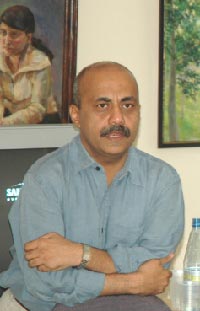 Quddus Mirza is an artist, art teacher, independent curator and art critic. He is one of the most well known artists of his generation. Graduated from the National College of Arts he later acquired MA in art from the Royal College of Art. He has shown extensively in numerous important group shows. In addition to these several of his personal exhibitions were held in different cities of Pakistan and in London . His work is part of major collections around the world, including the British Museum.
Quddus Mirza is an artist, art teacher, independent curator and art critic. He is one of the most well known artists of his generation. Graduated from the National College of Arts he later acquired MA in art from the Royal College of Art. He has shown extensively in numerous important group shows. In addition to these several of his personal exhibitions were held in different cities of Pakistan and in London . His work is part of major collections around the world, including the British Museum.
Along with his own art work, he has emerged as one of the leading curator from Pakistan, with various shows held in the country and outside, such as ‘One to One' at Alhamra Art Gallery, Lahore, ‘Beyond Borders' at NGMA, Mumbai and ‘Exotic Bodies' at Harris Museum, UK. Apart from these, he taught at art colleges, including Cleveland Institute of Art and Rhodes Island School of Design in USA, Delhi college of Art and Rajesthan School of Art in India , and at Bilkent University in Ankara . He also read papers on different aspects of art at conferences and seminars, both inside the country and abroad.
Quddus Mirza has been contributing in the realm of art criticism through his writings. He is the co-author of '50 Years of Visual Arts in Pakistan '. His articles appear in the national dailies such as The News and Dawn, as well as in various other international publications. Through these articles he has set a pattern to make a comment on art, which is objective, logic and unbiased. His writings reflect the analytical approach and an effort to link the art to the wholeness of society. With all these facets of his art activity, painting, teaching, curating and writing, he has contributed in the present art of Pakistan on an enormous scale.
“Occident And Accidents”
This paper addresses the issue of the revival of a traditional genre, the miniature painting in Pakistan . The modern miniature, as a phenomenon, has been haunting curators, not only in Pakistan but outside as well. Here I analyse this revival in a broader social, economic and cultural context. I trace the links with other revivalist tendencies in the region, especially the fundamentalist ideologies that have grown in the name of religion, tradition and ethnicity.
Today the question of ethnicity is important in reference to any scheme of representation, particularly through the visual arts. Normally an artwork or a certain body of works is selected by local or foreign curators in order to present a particular picture of society that may not resemble actuality. The international response to modern miniatures has generated a specific reaction among the local practitioners of miniature painting, its collectors and curators. The majority view this art form as the only possible solution to the questions such as ‘tradition and modernity', ‘East and West', ‘indigenous and alien', which reflect the inner dilemma for a person living in this age. In a way, the modern miniature provides a satisfactory answer to these issues.
However, while addressing this conflict, the miniature turns into a tool for marketing one's exotic self/part in the world. Hence the subject, imagery and techniques employed in its modern form reveal the urge to carve a niche in the world art based upon its exotic value and unusual qualities. Several curators present this aspect, which completes an Orientalizing agenda in the present time/situation.
Since modernity has not grown as a natural and logical phenomenon in our midst, and was imported as an idea/device/fashion, the change that occurred in the tradition of miniature painting is a process that began with the desire to be modern, rather than as the outcome of modernity. This superficiality is evident in the way miniature art is prepared/perceived as if it is a product for the ‘art tourist' – the curator who comes from USA, Europe or even from Japan and Australia – spends a few hours or days in Lahore, gets dazzled by the size, workmanship, colours, motifs and elements of heritage in the small and easily transportable works on paper and decides that the modern miniature is the true and authentic visual expression of this society. A verdict which is believed by the local artists, critics and curators too.
This paper is an attempt to dissect the perception, assumptions and patronage of the curator from Occident and the aesthetic accidents that are bound to happen during/due to his visit, and how all need to survive in these monstrous moments.
KAZAKHSTAN:
Almas Ordabayev
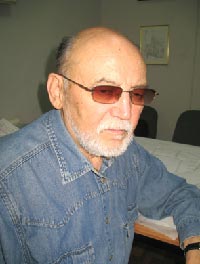 Born in 1938. Architect. He has studied in Saint Petersburg and Almaty. PhD in Architecture. Honored Architect of Kazakhstan . Activities: architectural projects; area, objects and graphic design; history of culture; history of architecture.
Born in 1938. Architect. He has studied in Saint Petersburg and Almaty. PhD in Architecture. Honored Architect of Kazakhstan . Activities: architectural projects; area, objects and graphic design; history of culture; history of architecture.
“Orientalistics.
From “Servant of Imperialism”
to Human Discourse”
Development of orientalistics as a branch of the world science in terms of developing international relations erases “white spots” in history and culture as well as “cleans” of oriental culture from “exotic spice”, so valued by turaregs and attracting western public. Nowadays the actual problems kept by centuries became to the first place are poverty, human rights, health care, education. Solving these problems and the same time keeping the cultural identity – is the main point of countries, which want to identify themselves in the new global world. On this way the field of oriental exotic getting narrow and partially moves to museums and theaters, partially stays in private collections, partially continue “to govern the society” by myths.
Zhannat Baimukhametov
 Scientist in culture, the philosopher, the poet-translator, the art critic. Graduated from the Al Farabi State University. Author of articles on problems of contemporary western and local philosophy, culture and art (Intellectual nomadism in contemporary western philosophy”, “Nomad arabesque: new art in Kazakhstan ”, “Province etocritics self-identification”, “Sex and civilization: project of gender ontology” etc. He is a translator of European poetry of P.Varlen, A.Rembo, P-M. Rilke, G.Trakl; and philosophy articles of P.Riker, S.Hantington, P.Kerni.
Scientist in culture, the philosopher, the poet-translator, the art critic. Graduated from the Al Farabi State University. Author of articles on problems of contemporary western and local philosophy, culture and art (Intellectual nomadism in contemporary western philosophy”, “Nomad arabesque: new art in Kazakhstan ”, “Province etocritics self-identification”, “Sex and civilization: project of gender ontology” etc. He is a translator of European poetry of P.Varlen, A.Rembo, P-M. Rilke, G.Trakl; and philosophy articles of P.Riker, S.Hantington, P.Kerni.
“Central Asian Art:
From Crisis of Identity to the Openness to Others”
Contemporary epoch of globalization requires the new view of yourself, of your own identity and avoiding the opposition “Me and Others”, “My own and Somebody's”. Central Asian art should learn to speak in two languages: first, meaning your own, and the second, responding to the others presence.
Bayan Barmankullova
 The Scientist in art. Graduated from the Moscow State University . She has experience of museum work, taught the courses of aesthetics and ethics, history of art, architecture, city architecture, culture, psychology of creation, movie critics. She writes about art, movie production in Kazakhstan . Author of over 150 articles on various topics.
The Scientist in art. Graduated from the Moscow State University . She has experience of museum work, taught the courses of aesthetics and ethics, history of art, architecture, city architecture, culture, psychology of creation, movie critics. She writes about art, movie production in Kazakhstan . Author of over 150 articles on various topics.
“Passion of Self-identification:
East From the West And West From the East”
Zigzags and labyrinths of cultural stages. Situation context: dual break in arrangement of universe of Kazakhs in 20th century. Click: traditional culture cracked and opened. Beginning with Kasteyev, the goal is Moscow , i.e. west, which is actually East for the real “Western” West. Then – Europe , America (the Southern and the Northern), Central Asian miniature. Click: the soviet culture cracked and again Kazakhstan is in the middle of periphery of art. Again action of the moving vector of passions, attractions and influences, among which is the most “Eastern” East. Ongoing striving to open up new, this is old for some cultures, but for “now and here” is critical. Always new is saying about yourself using any assimilative formal means.
Dana Safarova&Larissa Pletnikova
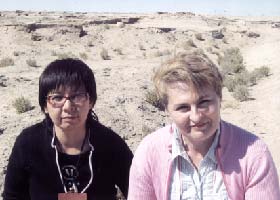 Larissa Pletnikova is the Director for the Desht-and-Art Center . She is the art historian, the curator, the art manager. She has many years of experience working in the museums and in the galleries. She is the author of researches and publications on cultural policy and art, on museum practice in Kazakhstan.
She was the curator for the following exhibitions: “The forgotten names. Soviet artists in Karaganda in 1930s – 1960s” ( Karaganda , 1990); “The new reality. Contemporary art in Kazakhstan ” ( Karaganda , 2000); “Eurasian syndrome” (Karaganda- Yekaterinburg-Nizhniy Tagil, 2002); “Landscapes of memory” ( Karaganda , 2002); “New mythology” ( Kazakhstan - Kyrgyzstan - Russia ).
Larissa Pletnikova is the Director for the Desht-and-Art Center . She is the art historian, the curator, the art manager. She has many years of experience working in the museums and in the galleries. She is the author of researches and publications on cultural policy and art, on museum practice in Kazakhstan.
She was the curator for the following exhibitions: “The forgotten names. Soviet artists in Karaganda in 1930s – 1960s” ( Karaganda , 1990); “The new reality. Contemporary art in Kazakhstan ” ( Karaganda , 2000); “Eurasian syndrome” (Karaganda- Yekaterinburg-Nizhniy Tagil, 2002); “Landscapes of memory” ( Karaganda , 2002); “New mythology” ( Kazakhstan - Kyrgyzstan - Russia ).
The author of the experimental museum projects “Destiny Trajectory” and “Minus 6”; awarded a diploma on the Open Museum Forum “Challenging Future” ( Russia , Yasnaya Polyana, 2004). She has organized and was the lecturer for the museum seminar “Innovative methods in the modern museum work” ( Kyrgyzstan , Kazakhstan , Tajikistan , 2005); and the curator for the museum festivals in Karaganda in 2005 and 2006.
Guldana Safarova is the Deputy Director for the Desht-and-Art Center . She is the art historian, the curator and the art manager, works for many years in museums. She is the author of researches and publications on cultural policy and art in Kazakhstan , on museum practice.
She is the curator for the following exhibitions: “The forgotten names. Soviet artists in Karaganda in 1930s – 1960s” ( Karaganda , 1990); “The new reality. Contemporary art in Kazakhstan ” ( Karaganda , 2000); “Eurasian syndrome” (Karaganda-Yekaterinburg-Nizhniy Tagil, 2002); “Landscapes of memory” ( Karaganda , 2002); “New mythology” ( Kazakhstan - Kyrgyzstan - Russia ).
The author of experimental museum projects “Destiny Trajectory” and “Minus 6”; awarded a diploma on the Open Museum Forum “Challenging Future” ( Russia , Yasnaya Polyana, 2004).
She has organized and was the lecturer for the museum seminar “Innovative methods in the modern museum work” ( Kyrgyzstan , Kazakhstan , Tajikistan , 2005); and the curator for the museum festivals in Karaganda in 2005 and 2006.
MUSEUMstan is the project for museums and people working on cultural heritage issues professionally and purposeful. The goal of the MUSEUMstan Project is to assist the museums in the former soviet Asian region to become the contemporary cultural centers through professional development and collaborations of museums' specialists. Therefore the MUSEUMstan program consists of seminars, competitions, and festivals, where the best specialists participate and who stimulate the participants to act creatively.
The objectives of the MUSEUMstan project are to initiate innovative museum events, to establish international communication network of organizations and people interested in development and improvement of museums status in the former soviet Asian countries. One of the most actual trends of the project is use of contemporary art practices, and collaboration of museums with contemporary artists.
The idea of the MUSEUMstan belongs to the Center of Contemporary Art Desht-and-Art ( Kazakhstan ) with the support of HIVOS, implemented with the collaboration with the Ministries and Departments of Culture, with the NGOs and with the international organizations. Countries participating in the MUSEUMstan project are Kyrgyzstan , Kazakhstan , Uzbekistan and Tajikistan .
Kamilla Lee
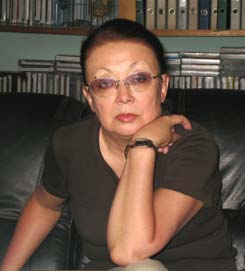 Kamilla Lee graduated from the Almaty Institute of Foreign Languages and from the Institute of Art , Sculpture and Architect named after Repin. Work experience: museum, the head artist for the Art Fund of the Artists Union of Kazakhstan, the president of the public fund “Culture Ecology” (Laboratory of intellectual property), and current position is the Executive Secretary of the Art Union of Kazakhstan . She published over 100 articles on issues of traditional and contemporary art in Kazakhstan . She deals with evaluation and protection of intellectual rights in culture.
Kamilla Lee graduated from the Almaty Institute of Foreign Languages and from the Institute of Art , Sculpture and Architect named after Repin. Work experience: museum, the head artist for the Art Fund of the Artists Union of Kazakhstan, the president of the public fund “Culture Ecology” (Laboratory of intellectual property), and current position is the Executive Secretary of the Art Union of Kazakhstan . She published over 100 articles on issues of traditional and contemporary art in Kazakhstan . She deals with evaluation and protection of intellectual rights in culture.
“From Edward Said to Said Atabekov”
Concept of Eurasia in context of new communications. Team or individual identity. Non actual search of East – orientation on the area. Our response to Chamberlin”, or total commercialization of sovereigns. Hope and danger of new orientalism (H. Kox): changing language – who is percipient?
UZBEKISTAN:
Aleksandr Djumayev
 Alexander Djumayev was born in 1953. He is a scientist in eastern music, the Science Candidate in Art, a member of the Uzbekistan Composers Union, a member of the International Board of Traditional Music. He is a member of the editing board of the international annual “Cultural Values” ( Saint Petersburg ), other periodicals. His science interests are history of music culture of the Central Asia ; Islam and Culture; cultural policy in Central Asia . He published over 100 scientific articles in various issues in Europe , USA , Russia , Uzbekistan and other countries. He lives in Tashkent .
Alexander Djumayev was born in 1953. He is a scientist in eastern music, the Science Candidate in Art, a member of the Uzbekistan Composers Union, a member of the International Board of Traditional Music. He is a member of the editing board of the international annual “Cultural Values” ( Saint Petersburg ), other periodicals. His science interests are history of music culture of the Central Asia ; Islam and Culture; cultural policy in Central Asia . He published over 100 scientific articles in various issues in Europe , USA , Russia , Uzbekistan and other countries. He lives in Tashkent .
Gaps, Links, New Cultural Identities”
In the report new view to the process of transformation of post-soviet cultures in Central Asia and Kazakhstan will be presented. Historical analogies to the modern transaction period will be revealed; new connections will be discussed. In the report various materials from art practice of Uzbekistan will be used.
KYRGYZSTAN:
Gamal Bokonbayev
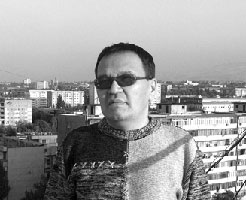 Bokonbayev Gamal is the designer, the critic, the curator. He was born in 1958 in Frunze (now Bishkek , Kyrgyzstan ), he graduated from Architecture Institute. He is a member of the Artists Union of Kyrgyzstan since 1997.
Bokonbayev Gamal is the designer, the critic, the curator. He was born in 1958 in Frunze (now Bishkek , Kyrgyzstan ), he graduated from Architecture Institute. He is a member of the Artists Union of Kyrgyzstan since 1997.
“Critical in Kyrgyzstan.
Post-Soviet Context: Contradictions And Rethinking”
Revolution is catalyst of concept of Inner context. Kyrgyz aesthetics of Europeanized contemporary art. Youth projects “I don't believe”, the project of the Fund of “Sergii Radonezhski and Manas Velikodushni”, the project of Maksim Kuleshov. New waves on edges of political and cultural actions.
TAJIKISTAN:
Sarvinoz Hojieva
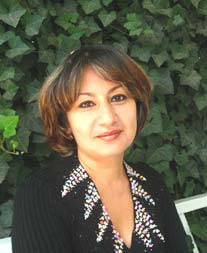 Member of the Artists' Union of Tajikistan, the art critic. Head editor of literature and culture programs of the Tajik TV. Author of programs for international TV company “Mir”. Teaches Culture course for the department of Pedagogy, Psychology and Culture in the Russian – Tajik Slavic University .
Member of the Artists' Union of Tajikistan, the art critic. Head editor of literature and culture programs of the Tajik TV. Author of programs for international TV company “Mir”. Teaches Culture course for the department of Pedagogy, Psychology and Culture in the Russian – Tajik Slavic University .
“Orientalism and Problems
of Cultural Identification And Gender”
Synthesis of two different schools – European and Eastern – was the basis for establishing of local cultural-identified models as well as for the creation of artists-nonconformists in Tajikistan. In the end of 19th and 20th centuries Russian avant-garde masters interested in Eastern culture, which was the beginning of so called “European orientalism”. The creation works of the artists, who was interested in ideas of East, like P.Falbov, B.Serebryanski, K.Turenko, S.Krasnopolski, P.Zobnin, I.Ivanov and others, change after visiting Tajikistan in 1930s. Such artists like E.Tatarinova, E.Nosik, E.Planitut, N.Dorysheva, Stoicheva and others educated in other countries, were professionally oriented to the achievements of western culture, including Russian culture, adding to the eastern traditions.